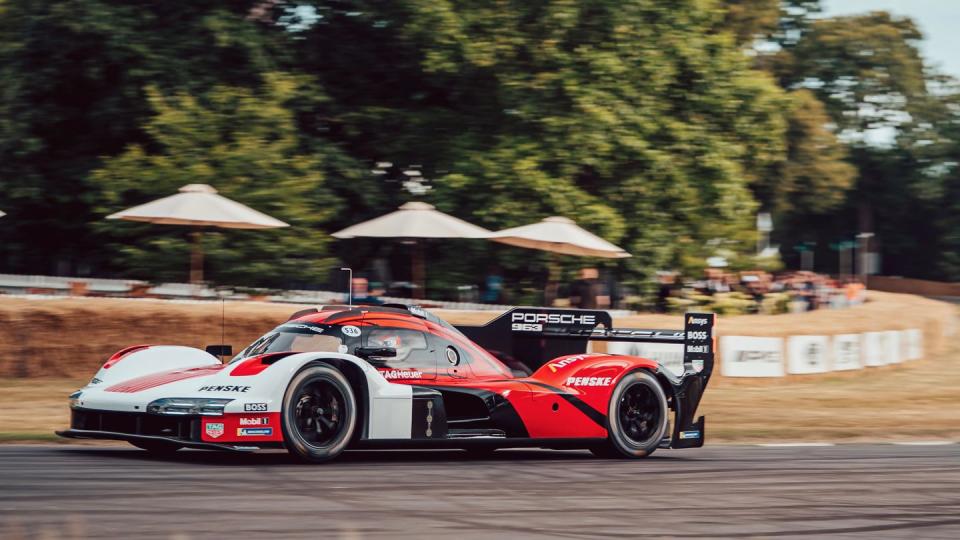Why IMSA Is Poised for an Renaissance in American Sports Car Racing


John Doonan is exceedingly nice. The Illinois native isn’t just “Midwestern nice” either. He’s widely considered one of the nicest men in motorsport [fig. 1]. His passion for racing can disarm even the most cynical among us. That’s a good thing in his line of work.
This story originally appeared in Volume 13 of Road & Track.
SIGN UP FOR THE TRACK CLUB BY R&T FOR MORE EXCLUSIVE STORIES
Since late 2019, Doonan has been president of the International Motor Sports Association (IMSA), the NASCAR-owned sanctioning body of the premier American sports-car-racing series. His job is to, essentially, keep a lot of people happy—promoters, advertisers, racers, automakers, drivers, fans, and many, many more. He’s also one of a handful presiding over the biggest shift in sports-prototype racing in a generation.
Not since 2013 has a top-level sports prototype been eligible to compete globally, and not since 1997 has a single car been able to run the triple crown of endurance racing: Daytona, Sebring, and Le Mans. That changes in 2023 with the introduction of LMDh, a new rule set agreed upon by IMSA and the ACO (governing body of the 24 Hours
of Le Mans) that promises to bring an unprecedented number of manufacturer entries to prototype endurance racing. In the new regulations scheme, the hybrid vehicles will be able to compete on even ground through the use of a balance-of-performance mechanism, with cars built to the FIA and ACO’s existing Le Mans Hypercar class.
Doonan’s first IMSA races as an attendee were at Road America in 1979—he was nine—and 1981, when the Grand Touring Prototype (GTP) era began. “It was magical,” he tells R&T in an interview held during the Northeast Grand Prix at Lime Rock Park. The idea with LMDh was to re-create the magic, and in the IMSA WeatherTech series, the GTP name was revived for the occasion. (LMDh is the type of car; GTP is the name of the class in which these cars will compete in the U.S.)
GTP “was a very memorable milestone in the history of IMSA,” Doonan says. “Let’s now, when we have this incredible opportunity for the OEMs to essentially do what they did back then, let’s re-create that. . . . And then, I think, as it relates to the cars being able to race across several platforms, the World Endurance Championship [WEC], Le Mans, and here, there was no question that we talked about that with the ACO and the FIA . . . about how there was a time where an OEM could build one car—it makes my hair stand up—one car here and race it there without as much as maybe changing the decal package.”

To entice automakers, LMDh has to be both affordable and valuable. In the past, prototype racing has tended to devolve into an unsustainable spending war, with automakers pricing themselves out of competing. Though never confirmed, it was rumored that Audi and Porsche spent around $200 million annually on their LMP1 programs in the middle of the last decade, which, if true, is firmly in pre-cost-cap Formula 1 territory. That just can’t work in a world where sports-car racing isn’t as big as F1.
Offering a global platform is already an appealing proposition, but the design of LMDh cars also helps keep development costs down while creating marketing value. Chassis come from either Dallara, Ligier, Multimatic, or Oreca, and a spec hybrid system is sourced from Bosch, Williams Advanced Engineering, and Xtrac [for more details, see “Hybrid Theory,” page 36]. Next year Acura and Cadillac will make the transition from IMSA’s current DPi formula to LMDh, with new entries from BMW and Porsche set to join the grid. In 2024, Lamborghini will run an LMDh car globally, while Alpine will build one just for the FIA’s WEC, which includes the 24 Hours of Le Mans.
Doonan was part of early discussions that led to LMDh in his previous role as head of Mazda Motorsports, a job he held for eight years to moderate success. (He was at Mazda for a total of 19 years.) He sees a large part of his job now as fostering collaborations among all of those with a vested interest in LMDh. “The only way, I think, in the end, to get to the unveiling in the first race of this new platform in 2023 is with everybody working together,” Doonan said in an earlier phone interview. “When that race starts, it’s every OEM for themselves, and they’ll go out and put on an amazing show. But to get us to the starting point, it’s been a very authentic level of communication among everybody to make sure that, collectively as a sport, we get to the right place, reliably, such that the cars can go out and perform.”
Doonan is quick to praise IMSA’s technical leads, Simon Hodgson and Matt Kurdock, and their counterpart at the ACO, Thierry Bouvet. He also says that while he misses being in the thick of competition, he is fascinated by the operation of the IMSA series and the challenges of being a series president.
“For me, actually, the business side of this sport—well, my dad and my grandfather were drivers—the business side is what always intrigued me,” he says. “I saw or felt that this could be a marketing tool, not just for the automakers, but for other brands that felt like this was fertile ground to either sell more product or build a brand.”
His job is, in part, to create a good place for automakers and advertisers to invest their money. Part of that is defining classes that are cost-effective to both enter and to stay in. “Another vision of ours is to make sure that we’re positioning ourselves, not just IMSA, but all the stakeholders, for a nice, clear path, such that when people make an investment to race here, whether it’s an OEM or an individual race team, they know roughly what’s coming for the next five years.”
LMDh cars will be subject to a five-year homologation, so theoretically, a car that joins the GTP category in 2023 will be competitive for years to come. The manufacturers have spoken—Doonan believes more will join the series too—and now it’s a matter of bringing more people to the show.
This is an interesting moment for motorsport in North America, with Formula 1 finally breaking through, NASCAR’s Next Gen car producing great racing, and Roger Penske’s successful takeover of IndyCar all providing huge opportunities. Doonan sees a chance to bring more people into sports-car racing, especially car enthusiasts who don’t know much about IMSA.
“For us, it’s about being present,” he says, “being vocal about our story, because you’re right: There’s a big spotlight on auto racing in general, and because of the number of OEMs that are participating, we have a very great story to tell and an incredible stage. . . . This is the ultimate laboratory and the ultimate proving ground. And we need to tell that story as much as we possibly can to take good advantage of the momentum that the whole sport has at the moment.”
Doonan thinks IMSA can replicate the success of NASCAR’s Next Gen car with GTP. “The Next Gen car has allowed Chevrolet, Ford, and Toyota to style more than [they did with] the previous-generation car,” he says. “And clearly, in GTP and LMDh, the designers were given a completely clear palette, obviously within a set of technical regulations, but when you see the Acura, the BMW, the Cadillac, the Porsche [fig. 1], and others that are yet to come, it is the ultimate expression of these brands.”
The fundamental appeal of sports-car racing has always been the obvious connection with road cars. Sure, the days of street-legal cars running at Le Mans and Daytona are long gone, but it’s still easy to draw the line between the cars you see on the street and those you see on track. And that’s why you get Porsche fans, Corvette fans, BMW fans, etc., at every race. Doonan feels that LMDh cars get to the heart of why sports-car racing is beloved in the first place.

“You should be able to pull an Acura GT car or an Acura road car up and position it next to the GTP car and see the brand,” he says. “I think what I’m most proud of and excited about for the whole sport is that I think we’ve achieved that. The OEMs have embraced that, and I think the fans will be the beneficiaries.”
Not that the new era for IMSA is assured success. It’s a tricky time to make big changes to a series that has historically taken a back seat to some of the others. F1’s popularity is exploding in the U.S. as never before, and NASCAR and IndyCar are on the rise, which means IMSA has to compete for attention. The economy faces serious uncertainty, which means the future of everything is up in the air. And motorsport is an exceedingly complex industry.
If nothing else, Doonan has enthusiasm on his side. His passion is infectious, and he comes off as someone willing to roll up his sleeves and unwilling to become jaded.
He might not have been working for IMSA when the seeds for LMDh were first sown, but he does seem like a man in the right place at the right time to achieve success. Apparently, it pays to be nice.
You Might Also Like

 Yahoo Autos
Yahoo Autos 